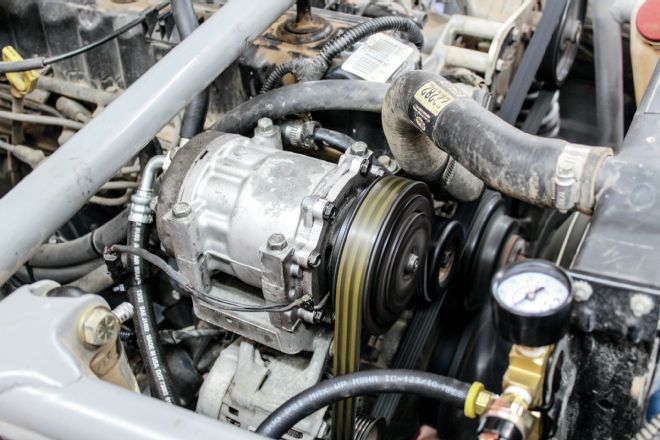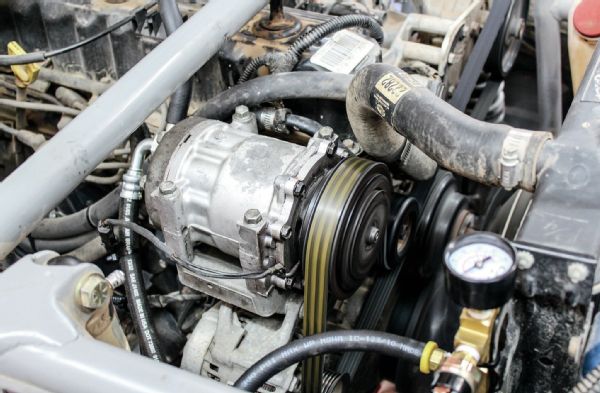
Wobbly Dodge
Q I have a ’99 Dodge 2500 4x4 that I can’t drive because of death wobble. I have replaced every part on the front end but the tires. The wheel bearings seem fine, as do the ball joints, which were replaced six years ago along with the steering box. The truck only has 104,000 miles on it. The body is in bad shape but it can be fixed, and the truck and is paid off so it’s worth fixing. What am I missing? By the way, my ’01 TJ does the same thing.
James K.
Via nuts@4wheeloffroad.com
A The coil spring/four-link suspension used on Dodge trucks and Jeep Wrangler TJs is a great overall design, but it’s not without its problems. By far the most common tech questions we receive are about fixing death wobble on either TJs or Dodge trucks. We’ve answered this question before but it has been awhile, so consider this a refresher.
Death wobble is the result of excessive wear or play somewhere in the front end, or a vehicle that is grossly out of alignment. Several things can trigger death wobble, including vehicle speed, hitting a bump in the road just right, or even tires that are a little out of balance. The trouble with death wobble is that it can be caused by many different components, so it can be hard to pin down. Here is how we like to tackle death wobble.
Start with the steering. Have someone cycle the steering back and forth while you closely observe all the linkage. Check the tie-rod and draglink ends for excessive play or other damage, check the steering shaft that connects the box to the steering wheel (they are notoriously bad on your Dodge), and check the steering box itself. While you’re there, check the track bar closely. The track bar on this type of suspension is under a lot of strain because it’s the only component holding the axle in place side-to-side; track bars are well known for going bad on both Dodge trucks and Jeeps. In our experience, the track bar is the culprit of death wobble about 60 percent of the time. Be sure to check both ends of the track bar; while the frame end is usually the problem, the bushing at the axle is prone to wear as well. Sometimes the track bar itself is fine, but its mounting holes in the axle or frame brackets have become egg-shaped. Remember that even a tiny bit of play in the track bar can cause death wobble. Several aftermarket upgrade solutions are available for both vehicles. If the vehicle is lifted, check to be sure the track bar is at the same operating angle as the draglink. If the track bar and draglink are out of phase, the vehicle will also have bumpsteer.
Check the rest of the suspension, paying close attention to the control arm bushings. Raise the front of the vehicle off the ground and check the wheel bearings and ball joints.
Have the alignment checked by a professional. Caster is especially important, and caster is reduced as a vehicle is lifted if it isn’t addressed somehow, such as with longer control arms, drop brackets for the stock control arms, or even larger caster cams.
Lastly, have the tires balanced and rotated. If your vehicle still has death wobble after all these checks, then start over at the beginning and check everything again.
The Right Air Source
Q I’ve recently installed ARB lockers into some 1-ton axles going under my rig, an ’01 Chevy Extended Cab Z-71. What is the best way to supply air to them? Do I install a belt-driven compressor under the hood? An electric compressor elsewhere? Do I need an air tank? I love driving this truck so it won’t be a trail-only vehicle (thus my reason for the air lockers), but its days as a workhorse are over. Eventually I plan on removing the bed altogether to move the rear axle forward and clear the way for bigger tires and obstacles. The engine has 200,000 original miles and runs great, but I wonder if the belt-driven compressor would be too much for it. Any help would be much appreciated.
Brian White
Via nuts@4wheeloffroad.com

A If you’re only concerned about air to activate the lockers and maybe fill up a tire occasionally, the easiest thing to do is mount a small electric compressor under the hood. ARB (arbusa.com) offers three compressors with different performance levels and price tags, and since they are designed to work with ARB’s Air Lockers, installation is simple plug-and-play. There are many other electric compressor choices as well, with various cfm ratings and price tags to match. Running an air tank isn’t necessary for just the lockers, but a tank is handy for filling up tires.
If you want an unlimited high-volume air source for things like running air tools and filling up big tires, it’s hard to beat a belt-driven compressor. Most of the units you see in the off-road world are converted air-conditioning compressors, such as a York or a Sanden. If you don’t care about A/C in your truck, you can convert the Sanden compressor that’s already on the truck into an air compressor. If your truck is not equipped with A/C, you can easily add a compressor using factory parts. If you want to retain the A/C system on your truck, you’ll need to figure out a way to mount a second compressor, which will be quite a bit of work. I did an article on converting a Sanden A/C compressor a couple of years ago for our sister publication Jp, and you can find the article on the Four Wheeler Network at fourwheeler.com/how-to/engine/154-1207-homemade-engine-driven-onboard-air-system/. Though a belt-driven compressor is a lot more work than wiring and plumbing an electric compressor, it’s hard to beat having a portable high-volume air source. With a decent-size air tank, you can do just about anything with a belt-driven compressor that you can do with your compressor at home. Even with a lot of miles on it, your engine will be more than capable of running a compressor.
Submission Information
Confused? Email your questions about trucks, 4x4s, and off-roading tech using “Nuts, I’m confused” as the subject and include a picture (if it’s applicable). Digital photos must measure no less than 1600 x 1200 pixels (or two megapixels) and be saved as a TIFF, an EPS, or a maximum-quality JPEG file. Also, I’ll be checking the forums on our website (4wheeloffroad.com), and if I see a question that I think more of you might want to have answered, I’ll print that as well. Otherwise drop it old-school style with the envelope addressed to the address below. Letters published in this magazine reflect the opinions of the writers, and we reserve the right to edit letters for clarity, brevity, or other purposes. Write to: Nuts & Bolts, 4-Wheel & Off-Road, 831 S. Douglas St., El Segundo, CA 90245 fax to: 818.566.8501 Email to: nuts@4wheeloffroad.com